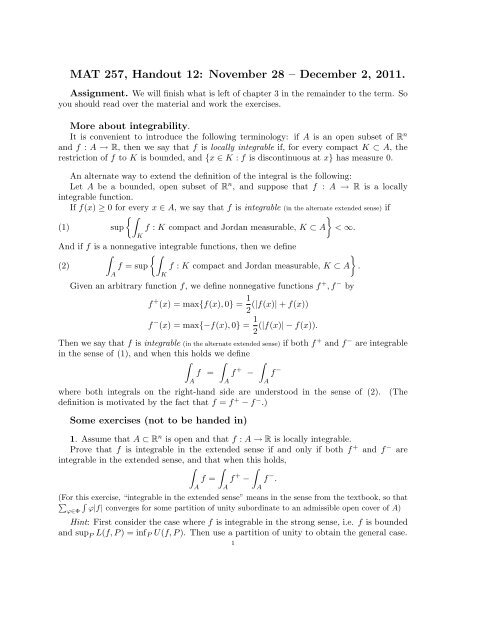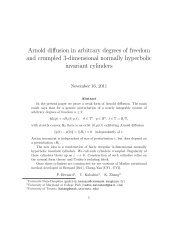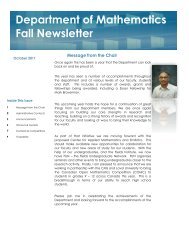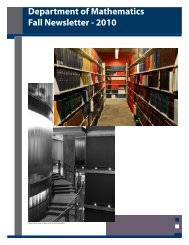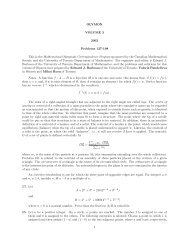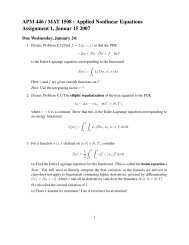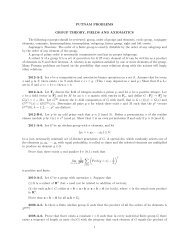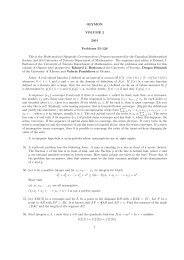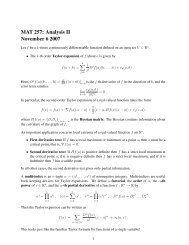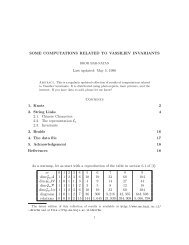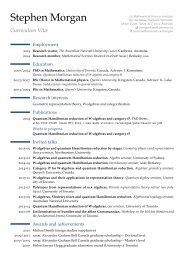MAT 257 Handout 12 November 28 – December 2 2011
MAT 257, Handout 12: November 28 â December 2, 2011.
MAT 257, Handout 12: November 28 â December 2, 2011.
You also want an ePaper? Increase the reach of your titles
YUMPU automatically turns print PDFs into web optimized ePapers that Google loves.
<strong>MAT</strong> <strong>257</strong>, <strong>Handout</strong> <strong>12</strong>: <strong>November</strong> <strong>28</strong> <strong>–</strong> <strong>December</strong> 2, <strong>2011</strong>.Assignment. We will finish what is left of chapter 3 in the remainder to the term. Soyou should read over the material and work the exercises.More about integrability.It is convenient to introduce the following terminology: if A is an open subset of R nand f : A → R, then we say that f is locally integrable if, for every compact K ⊂ A, therestriction of f to K is bounded, and {x ∈ K : f is discontinuous at x} has measure 0.An alternate way to extend the definition of the integral is the following:Let A be a bounded, open subset of R n , and suppose that f : A → R is a locallyintegrable function.If f(x) ≥ 0 for every x ∈ A, we say that f is integrable (in the alternate extended sense) if{∫}(1) sup f : K compact and Jordan measurable, K ⊂ A < ∞.KAnd if f is a nonnegative integrable functions, then we define∫ {∫}(2)f = sup f : K compact and Jordan measurable, K ⊂ A .AKGiven an arbitrary function f, we define nonnegative functions f + , f − byf + (x) = max{f(x), 0} = 1 (|f(x)| + f(x))2f − (x) = max{−f(x), 0} = 1 (|f(x)| − f(x)).2Then we say that f is integrable (in the alternate extended sense) if both f + and f − are integrablein the sense of (1), and when this holds we define∫ ∫ ∫f = f + − f −Awhere both integrals on the right-hand side are understood in the sense of (2).definition is motivated by the fact that f = f + − f − .)Some exercises (not to be handed in)AA(The1. Assume that A ⊂ R n is open and that f : A → R is locally integrable.Prove that f is integrable in the extended sense if and only if both f + and f − areintegrable in the extended sense, and that when this holds,∫ ∫ ∫f = f + − f − .AA(For this exercise, “integrable in the extended sense” means in the sense from the textbook, so that∑ϕ∈Φ∫ϕ|f| converges for some partition of unity subordinate to an admissible open cover of A)Hint: First consider the case where f is integrable in the strong sense, i.e. f is boundedand sup P L(f, P ) = inf P U(f, P ). Then use a partition of unity to obtain the general case.1A
22. Assume that A ⊂ R n is open and that f : A → R is locally integrable.Prove that if f(x) ≥ 0 for all x, then f is integrable in the extended sense from thetextbook if and only if f is integrable in the sense of definition (1), and in addition that{∫}sup f : K compact and Jordan measurable., K ⊂ A = ∑ ∫ϕf.Kϕ∈Φso that the two notions of extended integral agree.3. Combine the two previous exercises to conclude that f is integrable in the extended(partition of unity) sense if and only if f is integrable in the alternate extended sense ofdefinition (1), and moreover that if f is integrable in either sense (and hence in both senses)then the two definitions of the integral coincide.If we have completed exercise 3 (or if we are willing to believe its conclusion withoutcompleting it), then we no longer need to distinguish between “integrable in the extendedsense” and “integrable in the alternate extended sense.”4. In the exercise below, it is a good idea to choose the definition of integrable, and thedefinition of the integral, that makes the exercise as easy to solve as possible.a. LetA := {(x, y) ∈ R 2 : 0 < x < 1, x < y < 2x},and define f : A → R by f(x, y) = x −2 . Determine whether f is integrable on A, and if soevaluate the integral ∫ A f.b. LetB := {(x, y) ∈ R 2 : 0 < x < 1, x 2 < y < 2x 2 },and define f : B → R by f(x, y) = x −2 . Determine whether f is integrable on B, and if soevaluate the integral ∫ B f.5. Define f : R → R by f(x) = x.a. Show that for any λ ∈ R, there exists a sequence of compact sets C n such thatand in additionC n ⊂ interior C n+1 for every n, R = ∪ ∞ n=1C n ,∫C nf = λ for every n.b. Does it follow that f is integrable on R, with ∫ Rf = λ? Why or why not?


